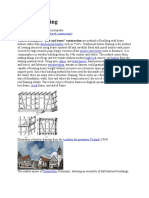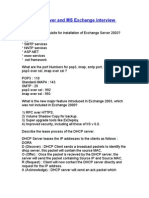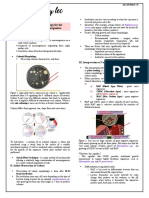The Non-Beginner's Guide To Syncing Data With Rsync PDF
The Non-Beginner's Guide To Syncing Data With Rsync PDF
Uploaded by
Joe JosephCopyright:
Available Formats
The Non-Beginner's Guide To Syncing Data With Rsync PDF
The Non-Beginner's Guide To Syncing Data With Rsync PDF
Uploaded by
Joe JosephOriginal Title
Copyright
Available Formats
Share this document
Did you find this document useful?
Is this content inappropriate?
Copyright:
Available Formats
The Non-Beginner's Guide To Syncing Data With Rsync PDF
The Non-Beginner's Guide To Syncing Data With Rsync PDF
Uploaded by
Joe JosephCopyright:
Available Formats
2/2/2016
The Non-Beginners Guide to Syncing Data with Rsync
rsyncCommands:SimpletoAdvanced
NowthattheWindowsusersareonthesamepage,letstakealookatasimplersynccommand,
andshowhowtheuseofsomeadvancedswitchescanquicklymakeitcomplex.
Letssayyouhaveabunchoffilesthatneedbackedupwhodoesntthesedays?Youplugin
yourportableharddrivesoyoucanbackupyourcomputersfiles,andissuethefollowingcommand:
rsync -a /home/geek/files/ /mnt/usb/files/
Or,thewayitwouldlookonaWindowscomputerwithCygwin:
rsync -a /cygdrive/c/files/ /cygdrive/e/files/
Prettysimple,andatthatpointtheresreallynoneedtousersync,sinceyoucouldjustdragand
dropthefiles.However,ifyourotherharddrivealreadyhassomeofthefilesandjustneedsthe
updatedversionsplusthefilesthathavebeencreatedsincethelastsync,thiscommandishandy
becauseitonlysendsthenewdataovertotheharddrive.Withbigfiles,andespeciallytransferring
filesovertheinternet,thatisabigdeal.
Backingupyourfilestoanexternalharddriveandthenkeepingtheharddriveinthesamelocation
asyourcomputerisaverybadidea,soletstakealookatwhatitwouldrequiretostartsending
yourfilesovertheinternettoanothercomputer(oneyouverented,afamilymembers,etc).
rsync -av --delete -e 'ssh -p 12345 /home/geek/files/
geek2@10.1.1.1:/home/geek2/files/
TheabovecommandwouldsendyourfilestoanothercomputerwithanIPaddressof10.1.1.1.It
woulddeleteextraneousfilesfromthedestinationthatnolongerexistinthesourcedirectory,output
thefilenamesbeingtransferredsoyouhaveanideaofwhatsgoingon,andtunnelrsyncthrough
SSHonport12345.
The-a -v -e --deleteswitchesaresomeofthemostbasicandcommonlyusedyoushould
alreadyknowagooddealaboutthemifyourereadingthistutorial.Letsgooversomeother
switchesthataresometimesignoredbutincrediblyuseful:
--progressThisswitchallowsustoseethetransferprogressofeachfile.Itsparticularlyuseful
whentransferringlargefilesovertheinternet,butcanoutputasenselessamountofinformation
whenjusttransferringsmallfilesacrossafastnetwork.
Anrsynccommandwiththe--progressswitchasabackupisinprogress:
http://www.howtogeek.com/175008/the-non-beginners-guide-to-syncing-data-with-rsync/
1/7
2/2/2016
The Non-Beginners Guide to Syncing Data with Rsync
--partialThisisanotherswitchthatisparticularlyusefulwhentransferringlargefilesoverthe
internet.Ifrsyncgetsinterruptedforanyreasoninthemiddleofafiletransfer,thepartially
transferredfileiskeptinthedestinationdirectoryandthetransferisresumedwhereitleftoffonce
thersynccommandisexecutedagain.Whentransferringlargefilesovertheinternet(say,acouple
ofgigabytes),theresnothingworsethanhavingafewsecondinternetoutage,bluescreen,or
humanerrortripupyourfiletransferandhavingtostartalloveragain.
-Pthisswitchcombines--progressand--partial,souseitinsteadanditwillmakeyour
rsynccommandalittleneater.
-zor--compressThisswitchwillmakersynccompressfiledataasitsbeingtransferred,
reducingtheamountofdatathathastobesenttothedestination.Itsactuallyafairlycommon
switchbutisfarfromessential,onlyreallybenefitingyouontransfersbetweenslowconnections,
anditdoesnothingforthefollowingtypesoffiles:7z,avi,bz2,deb,g,ziso,jpeg,jpg,mov,mp3,
mp4,ogg,rpm,tbz,tgz,z,zip.
-hor--human-readableIfyoureusingthe--progressswitch,youlldefinitelywanttouse
thisoneaswell.Thatis,unlessyouliketoconvertbytestomegabytesonthefly.The-hswitch
convertsalloutputtednumberstohumanreadableformat,soyoucanactuallymakesenseofthe
amountofdatabeingtransferred.
-nor--dry-runThisswitchisessentialtoknowwhenyourefirstwritingyourrsyncscriptand
testingitout.Itperformsatrialrunbutdoesntactuallymakeanychangesthewouldbechanges
arestilloutputtedasnormal,soyoucanreadovereverythingandmakesureitlooksokaybefore
rollingyourscriptintoproduction.
-Ror--relativeThisswitchmustbeusedifthedestinationdirectorydoesntalreadyexist.
Wewillusethisoptionlaterinthisguidesothatwecanmakedirectoriesonthetargetmachinewith
timestampsinthefoldernames.
--exclude-fromThisswitchisusedtolinktoanexcludelistthatcontainsdirectorypathsthat
youdontwantbackedup.Itjustneedsaplaintextfilewithadirectoryorfilepathoneachline.
--include-fromSimilarto--exclude-from,butitlinkstoafilethatcontainsdirectoriesand
http://www.howtogeek.com/175008/the-non-beginners-guide-to-syncing-data-with-rsync/
2/7
2/2/2016
The Non-Beginners Guide to Syncing Data with Rsync
filepathsofdatayouwantbackedup.
--statsNotreallyanimportantswitchbyanymeans,butifyouareasysadmin,itcanbehandy
toknowthedetailedstatsofeachbackup,justsoyoucanmonitortheamountoftrafficbeingsent
overyournetworkandsuch.
--log-fileThisletsyousendthersyncoutputtoalogfile.Wedefinitelyrecommendthisfor
automatedbackupsinwhichyouarenttheretoreadthroughtheoutputyourself.Alwaysgivelog
filesaonceoverinyoursparetimetomakesureeverythingisworkingproperly.Also,itsacrucial
switchforasysadmintouse,soyourenotleftwonderinghowyourbackupsfailedwhileyouleftthe
internincharge.
Letstakealookatourrsynccommandnowthatwehaveafewmoreswitchesadded:
rsync -avzhP --delete --stats --logfile=/home/geek/rsynclogs/backup.log --exclude-from
'/home/geek/exclude.txt' -e 'ssh -p 12345' /home/geek/files/
geek2@10.1.1.1:/home/geek2/files/
Thecommandisstillprettysimple,butwestillhaventcreatedadecentbackupsolution.Even
thoughourfilesarenowintwodifferentphysicallocations,thisbackupdoesnothingtoprotectus
fromoneofthemaincausesofdataloss:humanerror.
SnapshotBackups
Ifyouaccidentallydeleteafile,aviruscorruptsanyofyourfiles,orsomethingelsehappens
wherebyyourfilesareundesirablyaltered,andthenyourunyourrsyncbackupscript,yourbacked
updataisoverwrittenwiththeundesirablechanges.Whensuchathingoccurs(notif,butwhen),
yourbackupsolutiondidnothingtoprotectyoufromyourdataloss.
Thecreatorofrsyncrealizedthis,andaddedthe--backupand--backup-dirargumentsso
userscouldrundifferentialbackups.Theveryfirstexampleonrsyncswebsiteshowsascript
whereafullbackupisruneverysevendays,andthenthechangestothosefilesarebackedupin
separatedirectoriesdaily.Theproblemwiththismethodisthattorecoveryourfiles,youhaveto
effectivelyrecoverthemsevendifferenttimes.Moreover,mostgeeksruntheirbackupsseveral
timesaday,soyoucouldeasilyhave20+differentbackupdirectoriesatanygiventime.Notonlyis
recoveringyourfilesnowapain,butevenjustlookingthroughyourbackedupdatacanbe
extremelytimeconsumingyoudhavetoknowthelasttimeafilewaschangedinordertofindits
mostrecentbackedupcopy.Ontopofallthat,itsinefficienttorunonlyweekly(orevenlessoften
insomecases)incrementalbackups.
Snapshotbackupstotherescue!Snapshotbackupsarenothingmorethanincrementalbackups,
buttheyutilizehardlinkstoretainthefilestructureoftheoriginalsource.Thatmaybehardtowrap
yourheadaroundatfirst,soletstakealookatanexample.
Pretendwehaveabackupscriptrunningthatautomaticallybacksupourdataeverytwohours.
http://www.howtogeek.com/175008/the-non-beginners-guide-to-syncing-data-with-rsync/
3/7
2/2/2016
The Non-Beginners Guide to Syncing Data with Rsync
Wheneverrsyncdoesthis,itnameseachbackupintheformatof:Backupmonthdayyeartime.
So,attheendatypicalday,wedhavealistoffoldersinourdestinationdirectorylikethis:
Whentraversinganyofthosedirectories,youdseeeveryfilefromthesourcedirectoryexactlyasit
wasatthattime.Yet,therewouldbenoduplicatesacrossanytwodirectories.rsyncaccomplishes
thiswiththeuseofhardlinkingthroughthe--link-dest=DIRargument.
Ofcourse,inordertohavethesenicelyandneatlydateddirectorynames,weregoingtohaveto
beefupourrsyncscriptabit.Letstakealookatwhatitwouldtaketoaccomplishabackup
solutionlikethis,andthenwellexplainthescriptingreaterdetail:
#!/bin/bash
#copy old time.txt to time2.txt
yes | cp ~/backup/time.txt ~/backup/time2.txt
#overwrite old time.txt file with new time
echo `date +%F-%I%p` > ~/backup/time.txt
#make the log file
echo > ~/backup/rsync-`date +%F-%I%p`.log
#rsync command
rsync -avzhPR --chmod=Du=rwx,Dgo=rx,Fu=rw,Fgo=r --delete --stats -log-file=~/backup/rsync-`date +%F-%I%p`.log --exclude-from
'~/exclude.txt' --link-dest=/home/geek2/files/`cat
~/backup/time2.txt` -e 'ssh -p 12345' /home/geek/files/
geek2@10.1.1.1:/home/geek2/files/`date +%F-%I%p`/
#dont forget to scp the log file and put it with the backup
scp -P 12345 ~/backup/rsync-`cat ~/backup/time.txt`.log
geek2@10.1.1.1:/home/geek2/files/`cat ~/backup/time.txt`/rsync-`cat
~/backup/time.txt`.log
Thatwouldbeatypicalsnapshotrsyncscript.Incasewelostyousomewhere,letsdissectitpiece
bypiece:
Thefirstlineofourscriptcopiesthecontentsoftime.txttotime2.txt.Theyespipeistoconfirmthat
wewanttooverwritethefile.Next,wetakethecurrenttimeandputitintotime.txt.Thesefileswill
comeinhandylater.
Thenextlinemakesthersynclogfile,namingitrsyncdate.log(wheredateistheactualdateand
time).
Now,thecomplexrsynccommandthatwevebeenwarningyouabout:
http://www.howtogeek.com/175008/the-non-beginners-guide-to-syncing-data-with-rsync/
4/7
2/2/2016
The Non-Beginners Guide to Syncing Data with Rsync
-avzhPR, -e, --delete, --stats, --log-file, --exclude-from, --link-dest
Justtheswitcheswetalkedaboutearlierscrollupifyouneedarefresher.
--chmod=Du=rwx,Dgo=rx,Fu=rw,Fgo=rThesearethepermissionsforthedestination
directory.Sincewearemakingthisdirectoryinthemiddleofourrsyncscript,weneedtospecify
thepermissionssothatourusercanwritefilestoit.
Theuseofdateandcatcommands
Weregoingtogoovereachuseofthedateandcatcommandsinsidethersynccommand,inthe
orderthattheyoccur.Note:wereawarethatthereareotherwaystoaccomplishthisfunctionality,
especiallywiththeuseofdeclaringvariables,butforthepurposeofthisguide,wevedecidedtouse
thismethod.
Thelogfileisspecifiedas:
~/backup/rsync-`date +%F-%I%p`.log
Alternatively,wecouldhavespecifieditas:
~/backup/rsync-`cat ~/backup/time.txt`.log
Eitherway,the--log-filecommandshouldbeabletofindthepreviouslycreateddatedlogfile
andwritetoit.
Thelinkdestinationfileisspecifiedas:
--link-dest=/home/geek2/files/`cat ~/backup/time2.txt`
Thismeansthatthe--link-destcommandisgiventhedirectoryofthepreviousbackup.Ifwe
arerunningbackupseverytwohours,andits4:00PMatthetimeweranthisscript,thenthe-link-destcommandlooksforthedirectorycreatedat2:00PMandonlytransfersthedatathathas
changedsincethen(ifany).
Toreiterate,thatiswhytime.txtiscopiedtotime2.txtatthebeginningofthescript,sothe--linkdestcommandcanreferencethattimelater.
Thedestinationdirectoryisspecifiedas:
geek2@10.1.1.1:/home/geek2/files/`date +%F-%I%p`
Thiscommandsimplyputsthesourcefilesintoadirectorythathasatitleofthecurrentdateand
http://www.howtogeek.com/175008/the-non-beginners-guide-to-syncing-data-with-rsync/
5/7
2/2/2016
The Non-Beginners Guide to Syncing Data with Rsync
time.
Finally,wemakesurethatacopyofthelogfileisplacedinsidethebackup.
scp -P 12345 ~/backup/rsync-`cat ~/backup/time.txt`.log
geek2@10.1.1.1:/home/geek2/files/`cat ~/backup/time.txt`/rsync-`cat
~/backup/time.txt`.log
Weusesecurecopyonport12345totakethersynclogandplaceitintheproperdirectory.To
selectthecorrectlogfileandmakesureitendsupintherightspot,thetime.txtfilemustbe
referencedviathecatcommand.Ifyourewonderingwhywedecidedtocattime.txtinsteadofjust
usingthedatecommand,itsbecausealotoftimecouldhavetranspiredwhilethersynccommand
wasrunning,sotomakesurewehavetherighttime,wejustcatthetextdocumentwecreated
earlier.
Automation
UseCrononLinuxorTaskScheduleronWindowstoautomateyourrsyncscript.Onethingyou
havetobecarefulofismakingsurethatyouendanycurrentlyrunningrsyncprocessesbefore
continuinganewone.TaskSchedulerseemstocloseanyalreadyrunninginstancesautomatically,
butforLinuxyoullneedtobealittlemorecreative.
MostLinuxdistributionscanusethepkillcommand,sojustbesuretoaddthefollowingtothe
beginningofyourrsyncscript:
pkill -9 rsync
Encryption
Nope,werenotdoneyet.Wefinallyhaveafantastic(andfree!)backupsolutioninplace,butallof
ourfilesarestillsusceptibletotheft.Hopefully,yourebackingupyourfilestosomeplacehundreds
ofmilesaway.Nomatterhowsecurethatfarawayplaceis,theftandhackingcanalwaysbe
problems.
Inourexamples,wehavetunneledallofourrsynctrafficthroughSSH,sothatmeansallofourfiles
areencryptedwhileintransittotheirdestination.However,weneedtomakesurethedestinationis
justassecure.Keepinmindthatrsynconlyencryptsyourdataasitisbeingtransferred,butthe
filesarewideopenoncetheyreachtheirdestination.
Oneofrsyncsbestfeaturesisthatitonlytransfersthechangesineachfile.Ifyouhaveallofyour
filesencryptedandmakeoneminorchange,theentirefilewillhavetoberetransmittedasaresult
oftheencryptioncompletelyrandomizingallofthedataafteranychange.
Forthisreason,itsbest/easiesttousesometypeofdiskencryption,suchasBitLockerforWindows
ordmcryptforLinux.Thatway,yourdataisprotectedintheeventoftheft,butfilescanbe
transferredwithrsyncandyourencryptionwonthinderitsperformance.Thereareotheroptions
http://www.howtogeek.com/175008/the-non-beginners-guide-to-syncing-data-with-rsync/
6/7
2/2/2016
The Non-Beginners Guide to Syncing Data with Rsync
availablethatworksimilarlytorsyncorevenimplementsomeformofit,suchasDuplicity,butthey
lacksomeofthefeaturesthatrsynchastooffer.
Afteryouvesetupyoursnapshotbackupsatanoffsitelocationandencryptedyoursourceand
destinationharddrives,giveyourselfapatonthebackformasteringrsyncandimplementingthe
mostfoolproofdatabackupsolutionpossible.
http://www.howtogeek.com/175008/the-non-beginners-guide-to-syncing-data-with-rsync/
7/7
You might also like
- Using Authentic Video in The Language Classroom Paperback FrontmatterDocument10 pagesUsing Authentic Video in The Language Classroom Paperback FrontmatterJeJen ZaelaniNo ratings yet
- Sample Final Exam EECS388 - Fall 2020Document19 pagesSample Final Exam EECS388 - Fall 2020Jeren ChenNo ratings yet
- DDWRT OpenVPN Server Setup Guide v2.01Document35 pagesDDWRT OpenVPN Server Setup Guide v2.01kickflip900No ratings yet
- Second Quarterly Test in Math 3 - TagalogDocument4 pagesSecond Quarterly Test in Math 3 - TagalogOLIVIA LUMBRE100% (8)
- Black BookDocument153 pagesBlack Bookrohan wagheNo ratings yet
- Final PortfolioDocument46 pagesFinal Portfoliol4u124100% (7)
- Problems, Causes and Cures: of Hardwood FloorsDocument24 pagesProblems, Causes and Cures: of Hardwood FloorsSin DraganNo ratings yet
- Navigating The Linux File System: (Edwin Achimbi)Document4 pagesNavigating The Linux File System: (Edwin Achimbi)Stephen EfangeNo ratings yet
- All Quizzes NOS130 Q & ADocument18 pagesAll Quizzes NOS130 Q & Athe_dude_abidesNo ratings yet
- Programming Microsoft Visual Basic 6.0: Francesco Balena 196Document3 pagesProgramming Microsoft Visual Basic 6.0: Francesco Balena 196Ashish SinglaNo ratings yet
- Homework 3Document4 pagesHomework 3Jenny MatuteNo ratings yet
- DDWRT OpenVPN Server Setup Public v1.96Document33 pagesDDWRT OpenVPN Server Setup Public v1.96pedrama2002No ratings yet
- 1988 Methods of Chaos Physics and Their Application To AcousticsDocument19 pages1988 Methods of Chaos Physics and Their Application To AcousticsDaniel RaportNo ratings yet
- 5.1.4.4 Packet Tracer - StudentDocument3 pages5.1.4.4 Packet Tracer - StudentAdam Iglesia Ü0% (1)
- 6.3.1.9 Lab - Exploring Router Physical CharacteristicsDocument8 pages6.3.1.9 Lab - Exploring Router Physical CharacteristicsSkyspyder0% (1)
- Woodwork Joints PDFDocument173 pagesWoodwork Joints PDFRobert Guerra RiveraNo ratings yet
- How To Install VM On VirtualBoxDocument11 pagesHow To Install VM On VirtualBoxroettgersNo ratings yet
- Install Oracle EBusiness R12.2 OEL6.7 Linux R12.2Document137 pagesInstall Oracle EBusiness R12.2 OEL6.7 Linux R12.2Arif Mohammed RangrezzNo ratings yet
- GoodSync-Manual-9 3 6 6Document69 pagesGoodSync-Manual-9 3 6 6José Eronides de Menezes SobrinhoNo ratings yet
- Gottstein TrustDocument107 pagesGottstein TrustopilioNo ratings yet
- Timber Framing: Half-Timbered ConstructionDocument45 pagesTimber Framing: Half-Timbered ConstructionkitstonNo ratings yet
- CMDDocument5 pagesCMDJanarraj RajandranNo ratings yet
- 10 Ways To Fix The Blue Screen of Death On Windows - WikihowDocument14 pages10 Ways To Fix The Blue Screen of Death On Windows - WikihowEng.Mohamed AboulfotohNo ratings yet
- How To Format A ComputerDocument29 pagesHow To Format A ComputerMac Dareel UrianoNo ratings yet
- How To Install Kali Linux On VirtualBox (Step by Step Screenshot Tutorial) PDFDocument1 pageHow To Install Kali Linux On VirtualBox (Step by Step Screenshot Tutorial) PDFm7md 3bd ellahNo ratings yet
- TCP/IP Lab Manual BEDocument44 pagesTCP/IP Lab Manual BEChinmay Deshpande100% (1)
- Linksys Official Support - Cascading or Connecting A Linksys Router To Another RouterDocument5 pagesLinksys Official Support - Cascading or Connecting A Linksys Router To Another RouterjemamimoNo ratings yet
- Windows Server and MS Exchange Interview QuestionsDocument6 pagesWindows Server and MS Exchange Interview QuestionsPandianNo ratings yet
- OpenWRT VlanDocument12 pagesOpenWRT VlanSuresh KNo ratings yet
- The PC Boot ProcessDocument12 pagesThe PC Boot ProcessRohith BhardwajNo ratings yet
- Desktop Engineering - 2011-07Document52 pagesDesktop Engineering - 2011-07Бушинкин ВладиславNo ratings yet
- IT Tech Schedule July - Oct 2019Document8 pagesIT Tech Schedule July - Oct 2019dhery idNo ratings yet
- Step by Step Guide For Instalinng Exchange 2013Document8 pagesStep by Step Guide For Instalinng Exchange 2013Mohammed IzhaarNo ratings yet
- Windows NT RegistryDocument55 pagesWindows NT Registryapi-3777069No ratings yet
- Part 1 Fundamentals of Ethernet LANsDocument16 pagesPart 1 Fundamentals of Ethernet LANsNOVA MAROCNo ratings yet
- Next Generation Ip (Ipv6)Document49 pagesNext Generation Ip (Ipv6)sud_mishraNo ratings yet
- DWA-525 A2 Manual v1.20 (DI)Document57 pagesDWA-525 A2 Manual v1.20 (DI)Reyna Villar LopezNo ratings yet
- Computer Hardware ServicingDocument5 pagesComputer Hardware ServicingJamae SantosNo ratings yet
- Drive PartitioningDocument6 pagesDrive PartitioningjeanNo ratings yet
- Learn Linux DD Command - 15 Examples With All OptionsDocument4 pagesLearn Linux DD Command - 15 Examples With All Optionskamakom78No ratings yet
- Computer HardwareDocument75 pagesComputer HardwareIfLah IToo100% (1)
- CS 403-Week 1 ModuleDocument24 pagesCS 403-Week 1 ModuleJudielyn CualbarNo ratings yet
- Visual Fox Pro 1Document53 pagesVisual Fox Pro 1Shiv PathakNo ratings yet
- Lesson 4: Calling The Toolbox From The Menus: Transcad 7 HelpDocument2 pagesLesson 4: Calling The Toolbox From The Menus: Transcad 7 HelpReinel RuizNo ratings yet
- FastCopy 2.08 Manual EnglishDocument10 pagesFastCopy 2.08 Manual EnglishRafael Nery BritoNo ratings yet
- 15 Command Line Tools To Monitor Linux Performance PDFDocument25 pages15 Command Line Tools To Monitor Linux Performance PDFVictor L Wamukoya100% (1)
- How To Remove Blank or Empty Rows in ExcelDocument10 pagesHow To Remove Blank or Empty Rows in Excelck_peyNo ratings yet
- ES-Microsoft IntuneDocument9 pagesES-Microsoft IntuneKim ChanNo ratings yet
- Synology Drive WPDocument18 pagesSynology Drive WPMark Brown100% (1)
- (Ebook - PDF) Untold Windows Tips and Secrets (Ankit Fadia)Document22 pages(Ebook - PDF) Untold Windows Tips and Secrets (Ankit Fadia)nimitkhanna7100% (1)
- Xigmanas - Rsync Basic Client Backup ConfigurationDocument5 pagesXigmanas - Rsync Basic Client Backup ConfigurationMiguelSisayNo ratings yet
- Backup and RestoreOnLinuxDocument4 pagesBackup and RestoreOnLinuxMohd AyoobNo ratings yet
- LinuxDocument175 pagesLinuxNiki TaranNo ratings yet
- Debian GNU/Linux CD Images: Solution: You Don't Need To Download The CD Images at AllDocument2 pagesDebian GNU/Linux CD Images: Solution: You Don't Need To Download The CD Images at AllWillians MojeszcykNo ratings yet
- Raspberry Pi - Part 18 - Backup RestoreDocument9 pagesRaspberry Pi - Part 18 - Backup RestoreArslan CoskunNo ratings yet
- Rsync ThesisDocument8 pagesRsync Thesisafknnkmeo100% (1)
- Build Amiga GCC 3.3.3 Cross Compiler For Linux or Windows: RequirmentsDocument14 pagesBuild Amiga GCC 3.3.3 Cross Compiler For Linux or Windows: RequirmentsMurat ÖzdemirNo ratings yet
- Rsync - Keeping Linux Files and Directories in Sync With Rsync - Enable SysadminDocument6 pagesRsync - Keeping Linux Files and Directories in Sync With Rsync - Enable SysadminKarthik BmNo ratings yet
- FAQ Nginx-Win VersionDocument3 pagesFAQ Nginx-Win Versioncoolasim79No ratings yet
- 12 RsyncDocument12 pages12 Rsyncd.vargasNo ratings yet
- Desktop HP 6000 Pro DisassemblyDocument9 pagesDesktop HP 6000 Pro DisassemblyJoe JosephNo ratings yet
- JellyDocument2 pagesJellyJoe JosephNo ratings yet
- Tri Blender TheoryDocument6 pagesTri Blender TheoryPiero Sanguineti AcevedoNo ratings yet
- New Syllabus of B.tech (Dairy Tech)Document50 pagesNew Syllabus of B.tech (Dairy Tech)Joe JosephNo ratings yet
- Main List: Ranked List For The Post of DAIRY EXTENSION OFFICER On 19240-34500 in DAIRY Development DepartmentDocument4 pagesMain List: Ranked List For The Post of DAIRY EXTENSION OFFICER On 19240-34500 in DAIRY Development DepartmentJoe JosephNo ratings yet
- Lemon Grass DistillateDocument9 pagesLemon Grass DistillateJoe Joseph100% (1)
- SlaughteringDocument69 pagesSlaughteringJoe JosephNo ratings yet
- Rsync (Remote Sync) - 10 Practical Examples of Rsync Command in LinuxDocument13 pagesRsync (Remote Sync) - 10 Practical Examples of Rsync Command in LinuxJoe Joseph100% (1)
- The Practice of Law Is A Noble ProfessionDocument3 pagesThe Practice of Law Is A Noble ProfessionKen TuazonNo ratings yet
- Chapter 8: Use of Colony Morphology For The Presumptive Identification of MicroorganismDocument6 pagesChapter 8: Use of Colony Morphology For The Presumptive Identification of MicroorganismSamanthaNo ratings yet
- Literature in Cyberspace: Piret ViiresDocument22 pagesLiterature in Cyberspace: Piret ViiresMiguel FelixNo ratings yet
- Department of Electrical and Electronic Engineering 431-102 Digital Systems 1: Fundamentals Assignment Two: QuestionsDocument4 pagesDepartment of Electrical and Electronic Engineering 431-102 Digital Systems 1: Fundamentals Assignment Two: QuestionsChristian GonzalezNo ratings yet
- Finish Work Book: by Jon Acuff, FinisherDocument15 pagesFinish Work Book: by Jon Acuff, FinisherShaik Abdulwahab100% (5)
- Linkages of Retailer Personality, Perceived Quality and Purchase Intention With Retailer Loyalty - A Study of Indian Non-Food RetailingDocument8 pagesLinkages of Retailer Personality, Perceived Quality and Purchase Intention With Retailer Loyalty - A Study of Indian Non-Food Retailingvks svkNo ratings yet
- Etsi Deus Non DareturDocument17 pagesEtsi Deus Non DareturRuby Angela DeOsio PeñaNo ratings yet
- ThanksgivingDocument36 pagesThanksgivingosasNo ratings yet
- KarnadDocument10 pagesKarnadAdithya NarayanNo ratings yet
- Bringing Human Factors Into Engineering Education Realm A Case Study Teaching Human Factors in Fire Protection EngineeringDocument9 pagesBringing Human Factors Into Engineering Education Realm A Case Study Teaching Human Factors in Fire Protection EngineeringSweln LayosaNo ratings yet
- Your Kids Will Love Peru Adventure in Their Next VacationDocument7 pagesYour Kids Will Love Peru Adventure in Their Next VacationJimmy BarkerNo ratings yet
- Lynas Risk Assessment On Rare Earth PlantDocument114 pagesLynas Risk Assessment On Rare Earth PlantchujiyoNo ratings yet
- 39 Alr 899Document156 pages39 Alr 899legalmatters100% (1)
- Additional Notes - Light Transmission Aggregometry NotesDocument7 pagesAdditional Notes - Light Transmission Aggregometry NotesAndrej TerzicNo ratings yet
- Word Combinations, Stress InversionDocument14 pagesWord Combinations, Stress InversionZeenat IshfaqNo ratings yet
- Appraisal of The Accounting System in Nigerian Public Sector (A Case Study of Selected Government Establishment in Enugu)Document62 pagesAppraisal of The Accounting System in Nigerian Public Sector (A Case Study of Selected Government Establishment in Enugu)Babah Silas VersilaNo ratings yet
- Buka J of Cosmetic Dermatology - 2022 - Arora - Cellulite Presentation and Management PDFDocument9 pagesBuka J of Cosmetic Dermatology - 2022 - Arora - Cellulite Presentation and Management PDFMamakNya VidyaNo ratings yet
- 29.232-2008.03 Hessa Al FalasiDocument134 pages29.232-2008.03 Hessa Al FalasiKochar A. SaeedNo ratings yet
- String 21Document19 pagesString 21Ozan AKYOLNo ratings yet
- An Application For Attachment Before JudgmentDocument3 pagesAn Application For Attachment Before Judgmentshubham madaan100% (1)
- SE Project Report Template OBE - v2Document7 pagesSE Project Report Template OBE - v2Cadet AdnanNo ratings yet
- Sheikh Tahir-Book Review-Julie Mullaney-Postcolonial Literatures in Context (2010) PDFDocument15 pagesSheikh Tahir-Book Review-Julie Mullaney-Postcolonial Literatures in Context (2010) PDFشیخطاھر100% (1)
- Christ and The Western Mind - Karl AdamDocument88 pagesChrist and The Western Mind - Karl AdamSamuel SantosNo ratings yet
- CPE240 Paper 8Document4 pagesCPE240 Paper 8Ahmad RezaNo ratings yet
- Testatika Generator and Over-UnityDocument2 pagesTestatika Generator and Over-UnityzcrackNo ratings yet
- Make The Dream A Reality - Pegasus NLPDocument4 pagesMake The Dream A Reality - Pegasus NLPathanasiusNo ratings yet
































































































